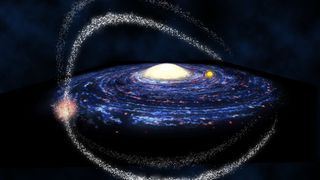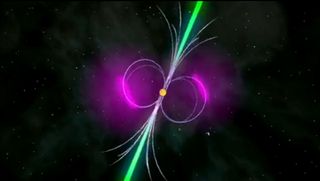Dead stars in Milky Way's companion galaxy cause mysterious gamma-ray cocoon
The Fermi bubbles are massive structures extending from the Milky Way, reaching 50,000 light-years in length.

Mysterious ultrabright gamma-ray emissions in the giant bubbles blown out by our galaxy may finally have an explanation.
Researchers used data from the Gaia and Fermi space telescopes to search through the Fermi bubbles, a pair of colossal hourglass-shaped bubbles that extend from the poles of the Milky Way and span 50,000 light-years, to trace the source of the very bright gamma-ray emission spots.
They discovered that one of the brightest of these spots, dubbed the "Fermi cocoon," located in the southern bubble, was caused by emissions from rapidly spinning dead stars called pulsars in the Milky Way's satellite galaxy Sagittarius. The finding could shed light on how these collapsed dead stars act as cosmic particle accelerators, blasting out high-energy particles that go on to cause gamma-ray emissions.
Related: Astronomers spot the brightest intergalactic pulsar yet beyond the Milky Way
Gamma-rays have previously been highlighted as a possible result of dark matter annihilation. But if gamma-rays are the result of particles accelerated by pulsars, they may not be evidence of dark matter.
The Sagittarius dwarf satellite galaxy is viewed from Earth through the Fermi bubbles and is marked by elongated streams of gas and stars that were ripped from the galaxy's core as its tight orbit threaded it through the disk of the Milky Way.
Gamma-ray emissions are thought to be created by young stars, by dark matter annihilation or by millisecond pulsars. This violent gas removal means that the Sagittarius dwarf galaxy is no longer forming stars and lacks stellar nurseries, so its gamma-ray emissions can't be the result of young stars.
Get the Space.com Newsletter
Breaking space news, the latest updates on rocket launches, skywatching events and more!
Furthermore, the shape of the Fermi cocoon closely matches the observed distribution of visible stars, ruling out dark matter as a source of the emissions. (If dark matter were present, its gravity would affect the shape of the cocoon). Thus, the researchers concluded that the only possible sources of this powerful radiation were a hitherto unknown population of millisecond pulsars, which are rapidly rotating, ultradense stellar remnants that spin hundreds of times per second.

"We are satisfied there is only one possibility: rapidly spinning objects called 'millisecond pulsars,'" the team wrote in an Australian National University statement. "Millisecond pulsars in the Sagittarius dwarf were the ultimate source of the mysterious cocoon, we found."
Like all neutron stars, a pulsar forms when a star much more massive than the sun reaches the end of its life and can no longer carry out nuclear fusion in its core. As a result, it can no longer support itself against complete gravitational collapse. Accompanied by a massive supernova blast, the gravitational collapse leaves behind a city-size star with a mass around that of the sun. This stellar remnant is composed of matter so dense that a teaspoon of it would weigh 4 billion tons.
Scientists think millisecond pulsars' rapid rotation is caused by the accretion of matter from a binary companion star that adds angular momentum to the dead star — or "spins it up."
Due to their powerful magnetic fields, the poles of pulsars blast out electrons and positrons (electrons' antimatter equivalents). When the electrons interact with low-energy photons that make up the cosmic microwave background (CMB) — radiation left over from shortly after the Big Bang — the electrons impart some of their kinetic energy. This causes CMB photons to become much more energetic gamma-ray photons.
By demonstrating that the gamma-ray cocoon is the result of pulsars, the team's results suggest that the gamma-ray emissions in the Fermi bubbles are not the result of dark matter annihilation, the researchers said.
"This is significant because dark matter researchers have long believed that an observation of gamma rays from a dwarf satellite would be a smoking-gun signature for dark matter annihilation," team co-leader Oscar Macias, a researcher at the University of Amsterdam, said in a statement. "Our study compels a reassessment of the high energy emission capabilities of quiescent stellar objects, such as dwarf spheroidal galaxies, and their role as prime targets for dark matter annihilation searches."
The team's research was published online Sept. 5 in the journal Nature Astronomy.
Follow us on Twitter @Spacedotcom or on Facebook.
Join our Space Forums to keep talking space on the latest missions, night sky and more! And if you have a news tip, correction or comment, let us know at: community@space.com.

Robert Lea is a science journalist in the U.K. whose articles have been published in Physics World, New Scientist, Astronomy Magazine, All About Space, Newsweek and ZME Science. He also writes about science communication for Elsevier and the European Journal of Physics. Rob holds a bachelor of science degree in physics and astronomy from the U.K.’s Open University. Follow him on Twitter @sciencef1rst.
